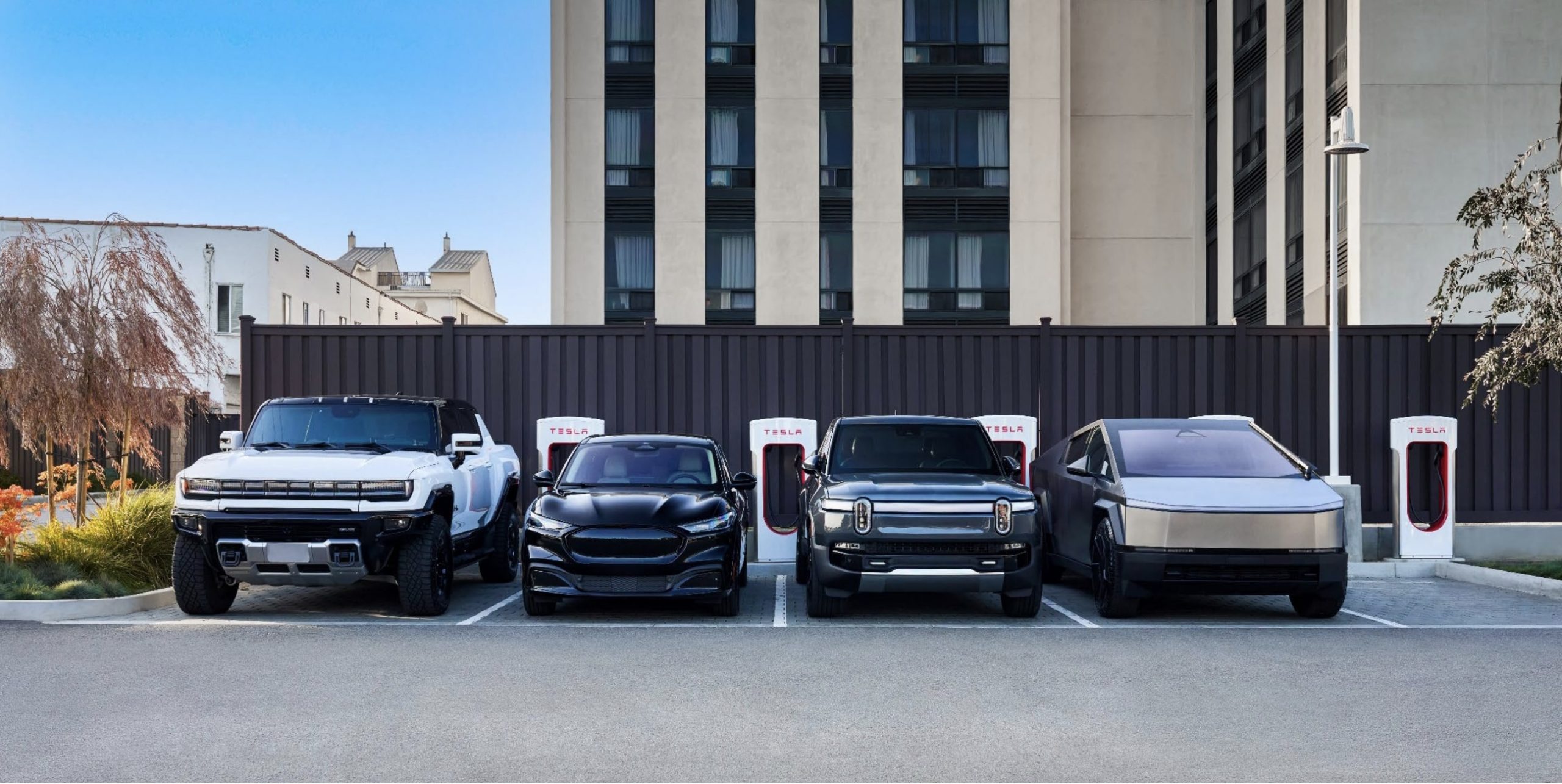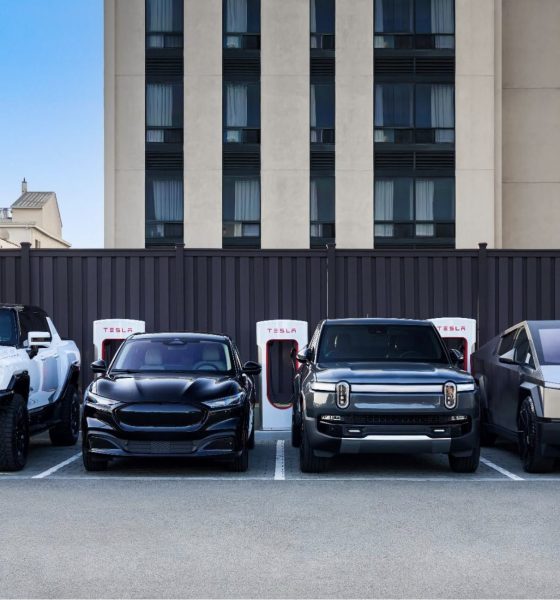U.S. President Donald Trump formally launched tariffs on imports from Canada, Mexico, and China over the weekend, a decision that is widely expected to have sweeping implications for Tesla, other automakers, and a broad range of other industries.
The Trump administration announced the news on Saturday, effectively establishing a 25-percent tariff on Canadian and Mexican imports as well as a 10-percent tariff on products from China. The tariffs will go into effect on Tuesday, and they have already caused ripple effects and a larger trade war with some of the companies.
Canada Prime Minister Justin Trudeau and Mexico President Claudia Sheinbaum spoke on the phone over the weekend, and while Sheinbaum hasn’t yet formalized or disclosed plans for counter-tariffs, Trudeau announced some on Saturday evening, according to Reuters. In the announcement, the Prime Minister said that Canada with also establish a 25-percent tariff on $155 billion worth of products from the U.S.
Trudeau has said that the government will release an updated list of products and tariff details, though the initial list included products such as certain appliances, beer, wine, lumber and other goods. He also says that the government plans to start with $30 billion on Tuesday, as followed by the additional $125 billion later this month.
The Trump administration says the tariffs are aimed at “addressing an emergency situation” related to the import of illegal drugs including fentanyl, along with pointing the blame at illegal immigrants.
“President Trump is taking bold action to hold Mexico, Canada, and China accountable to their promises of halting illegal immigration and stopping poisonous fentanyl and other drugs from flowing into our country,” the White House writes on its fact sheet dedicated to the order.
You can see the full fact sheet from the White House here, or check out the full executive order here.
Tesla joins group of automakers suing EU for EV tariffs from China-built cars
READ MORE ON U.S. PRODUCTION: Tesla Texas lithium refinery produces its first spodumene
Trump follows up, auto workers weigh in on how tariffs will affect the industry
On Sunday, Trump also followed up with a post on his Truth Social account in response to criticism:
The USA has major deficits with Canada, Mexico, and China (and almost all countries!), owes 36 Trillion Dollars, and we’re not going to be the “Stupid Country” any longer. MAKE YOUR PRODUCT IN THE USA AND THERE ARE NO TARIFFS! Why should the United States lose TRILLIONS OF DOLLARS IN SUBSIDIZING OTHER COUNTRIES, and why should these other countries pay a small fraction of the cost of what USA citizens pay for Drugs and Pharmaceuticals, as an example? THIS WILL BE THE GOLDEN AGE OF AMERICA! WILL THERE BE SOME PAIN? YES, MAYBE (AND MAYBE NOT!). BUT WE WILL MAKE AMERICA GREAT AGAIN, AND IT WILL ALL BE WORTH THE PRICE THAT MUST BE PAID.
Following a repost of Trump’s words on X, community notes pointed to a TD Economics saying that the U.S. has had a trade surplus with Canada for the last sixteen years straight when not including the energy sector, or oil, natural gas and electricity.
Multiple others have weighed in on how the tariffs could affect the industry at large, highlighting the potential for price increases for the consumer, potential layoffs, and some even saying that it will shut the auto industry down altogether.
In a report from Bloomberg on Sunday, Flavio Volpe, the President of the Canada Automotive Parts Manufacturers’ Association, said that he doesn’t think the country’s auto parts makers will be able to remain profitable with the tariffs in place.
“The auto sector is going to shut down within a week,” Volpe said. “At 25 percent, absolutely nobody in our business is profitable by a long shot.”
Others have warned of even more immediate effects, especially for Canadian and Mexican cities and states whose communities rely heavily on automotive manufacturing. One such city includes Windsor, Ontario, where John D’Agnolo, the union president of a local Ford factory there, says substantial numbers of layoffs could be imminent.
“We’re talking about thousands and thousands of jobs being lost,” D’Agnolo said. “We’d truly be a ghost town, here in Windsor, if we lost this type of business.”
Ontario Premier Doug Ford has also warned that it could affect as many as 500,000 jobs across the province, which is Canada’s most populated, with many of those being automotive roles.
Many also expect the increased costs to be passed onto the consumer, though it’s still unclear exactly what the repercussions of the tariffs could be. We could also see businesses absorb some or all of these costs, though some initial research seems to suggest that buyers will see higher sticker prices across the industry.
“It is going to be a lot of impact,” Aruna Anand, chief executive officer of parts supplier Continental AG’s North American business, said in an interview. “The question is who is absorbing the price and it becomes, are we able to absorb that price or is it going to be shifted to the end consumer?”
In a separate report from Reuters on Saturday, it was suggested that automakers such as General Motors (GM) and Toyota could, however, shift more production from overseas factories to those in the U.S., while major aluminum manufacturer Alcoa is considering re-routing plans that could potentially reduce tariffs. Many electric vehicle (EV) battery materials also come from metal mining operations in China, with some of these sectors just beginning to emerge domestically.
Others also report that the move could “undermine competitiveness” in the American auto industry, ultimately increasing the cost of building cars in the U.S.
“Our American automakers … should not have their competitiveness undermined by tariffs that will raise the cost of building vehicles in the United States and stymie investment in the American workforce,” says Matt Blunt, the President of the American Automotive Policy Council, which represents Stellantis, GM and Ford.
During Tesla’s Q4 earnings call last week, Chief Financial Officer Vaibhav Taneja also warned that tariffs could affect profitability for the company, since its all of its production facilities utilize parts from around the globe.
“There’s a lot of uncertainty around tariffs,” Taneja said. “Over the years, we’ve tried to localize our supply chain in every market, but we are still very reliant on parts from across the world for all our businesses. Therefore, the imposition of tariffs, which is very likely, will have an impact on our business and profitability.”
It’s still not quite clear at this time how the tariffs may affect Tesla’s prices. While Tesla has regularly advertised having the “most American-made cars” with final assembly for the market taking place at its factories in Texas and California, the company also gets a significant amount of components from Canada.
In a filing with the National Highway Traffic Safety Administration (NHTSA) in October, Tesla did disclose what percentage of its vehicle parts are made in either Canada or the U.S., as compared to other countries such as Mexico and Japan. Some of the figures also don’t disclose where the remaining amounts come from, though they can give users an idea of how many components come from Mexico compared to either the U.S. or Canada.
You can see that data for Tesla’s vehicles below, though it’s also worth noting that it does not show the ratio of U.S. to Canadian parts—just a combined percentage from the two countries. You can also view the full filing from the NHTSA here.
- Cybertruck: 65 percent from U.S. and Canada; 25 percent from Mexico
- Model 3 Long Range: 75 percent from U.S. and Canada; 20 percent from Mexico
- Model 3 Performance: 70 percent from U.S. and Canada; 20 percent from Mexico
- Model Y (all trims): 70 percent from U.S. and Canada; 25 percent from Mexico
- Model S: 65 percent from U.S. and Canada; 20 percent from Mexico
- Model X: 60 percent from U.S. and Canada; 25 percent from Mexico
What are your thoughts? Let me know at zach@teslarati.com, find me on X at @zacharyvisconti, or send us tips at tips@teslarati.com.
Tesla Mexico nearshoring concerns brought up by CMIC presidential candidate
Need accessories for your Tesla? Check out the Teslarati Marketplace:

Elon Musk
Elon Musk proposes Grok 5 vs world’s best League of Legends team match
Musk’s proposal has received positive reception from professional players and Riot Games alike.
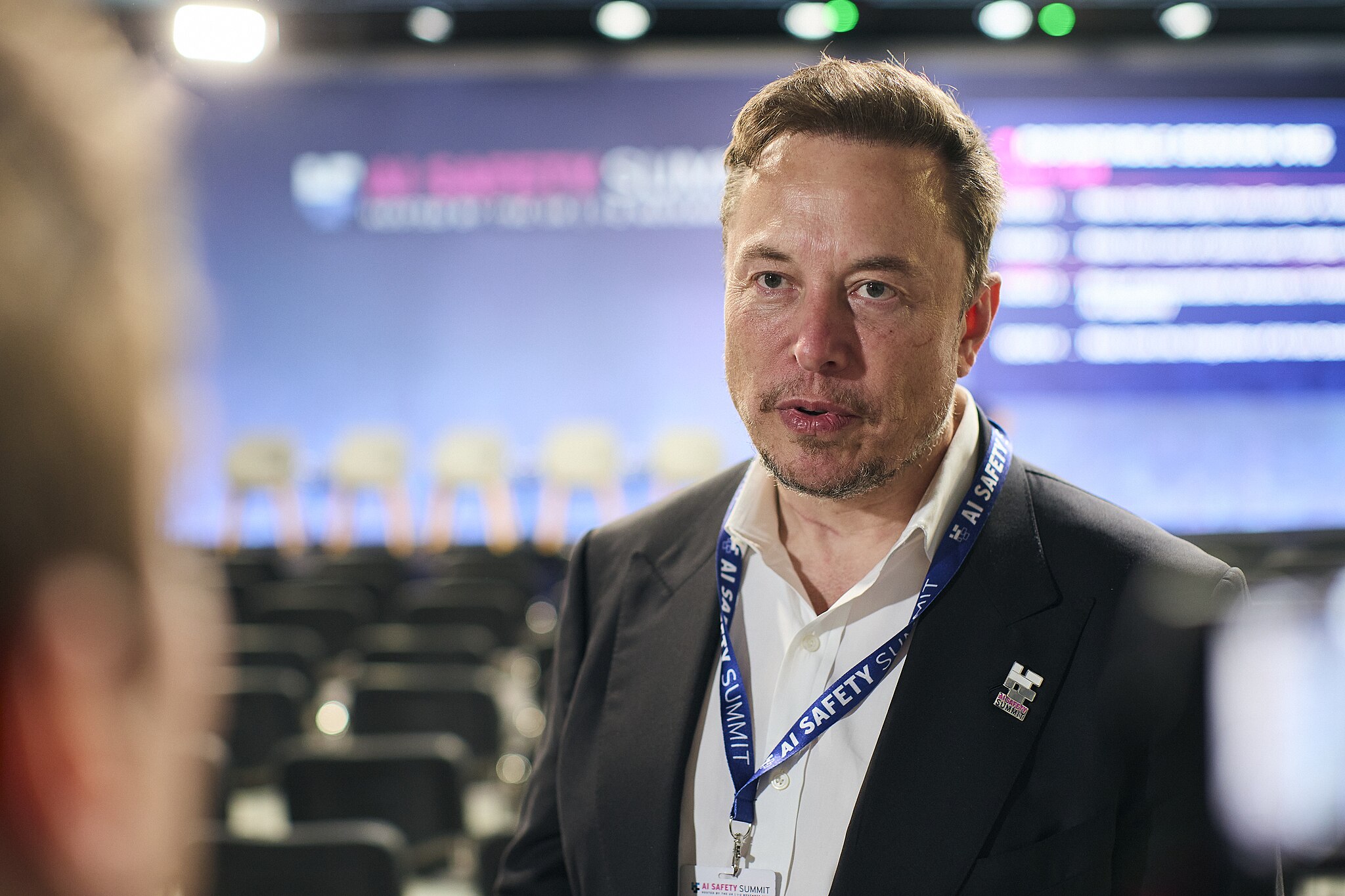
Elon Musk has proposed a high-profile gaming challenge for xAI’s upcoming Grok 5. As per Musk, it would be interesting to see if the large language model could beat the world’ best human League of Legends team with specific constraints.
Musk’s proposal has received positive reception from professional players and Riot Games alike, suggesting that the exciting exhibition match might indeed happen.
Musk outlines restrictions for Grok
In his post on X, Musk detailed constraints to keep the match competitive, including limiting Grok to human-level reaction times, human-speed clicking, and viewing the game only through a camera feed with standard 20/20 vision. The idea quickly circulated across the esports community, drawing commentary from former pros and AI researchers, as noted in a Dexerto report.
Former League pro Eugene “Pobelter” Park expressed enthusiasm, offering to help Musk’s team and noting the unique comparison to past AI-versus-human breakthroughs, such as OpenAI’s Dota 2 bots. AI researcher Oriol Vinyals, who previously reached Grandmaster rank in StarCraft, suggested testing Grok in RTS gameplay as well.
Musk welcomed the idea, even responding positively to Vinyals’ comment that it would be nice to see Optimus operate the mouse and keyboard.
Pros debate Grok’s chances, T1 and Riot show interest
Reactions weren’t universally optimistic. Former professional mid-laner Joedat “Voyboy” Esfahani argued that even with Grok’s rapid learning capabilities, League of Legends requires deep synergy, game-state interpretation, and team coordination that may be difficult for AI to master at top competitive levels. Yiliang “Doublelift” Peng was similarly skeptical, publicly stating he doubted Grok could beat T1, or even himself, and jokingly promised to shave his head if Grok managed to win.
T1, however, embraced the proposal, responding with a GIF of Faker and the message “We are ready,” signaling their willingness to participate. Riot Games itself also reacted, with co-founder Marc Merrill replying to Musk with “let’s discuss.” Needless to say, it appears that Riot Games in onboard with the idea.
Though no match has been confirmed, interest from players, teams, and Riot suggests the concept could materialize into a landmark AI-versus-human matchup, potentially becoming one of the most viewed League of Legends events in history. The fact that Grok 5 will be constrained to human limits would definitely add an interesting dimension to the matchup, as it could truly demonstrate how human-like the large language model could be like in real-time scenarios.
Tesla has passed a key milestone, and it was one that CEO Elon Musk initially mentioned more than nine years ago when he published Master Plan, Part Deux.
As per Tesla China in a post on its official Weibo account, the company’s Autopilot system has accumulated over 10 billion kilometers of real-world driving experience.
Tesla China’s subtle, but huge announcement
In its Weibo post, Tesla China announced that the company’s Autopilot system has accumulated 10 billion kilometers of driving experience. “In this respect, Tesla vehicles equipped with Autopilot technology can be considered to have the world’s most experienced and seasoned driver.”
Tesla AI’s handle on Weibo also highlighted a key advantage of the company’s self-driving system. “It will never drive under the influence of alcohol, be distracted, or be fatigued,” the team wrote. “We believe that advancements in Autopilot technology will save more lives.”
Tesla China did not clarify exactly what it meant by “Autopilot” in its Weibo post, though the company’s intense focus on FSD over the past years suggests that the term includes miles that were driven by FSD (Beta) and Full Self-Driving (Supervised). Either way, 10 billion cumulative miles of real-world data is something that few, if any, competitors could compete with.
Advertisement
–>
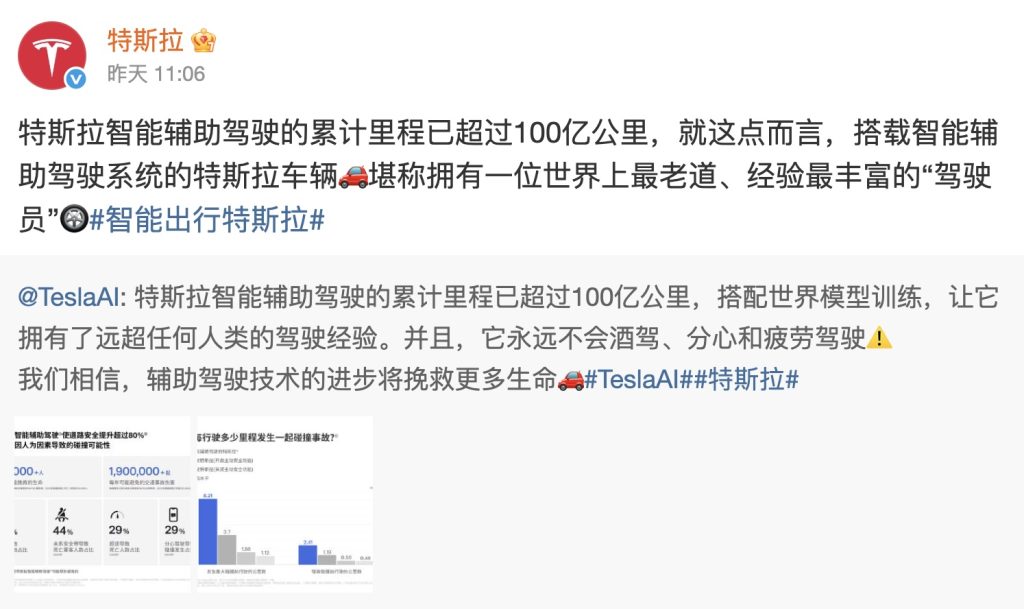
Elon Musk’s 10-billion-km estimate, way back in 2016
When Elon Musk published Master Plan Part Deux, he outlined his vision for the company’s autonomous driving system. At the time, Autopilot was still very new, though Musk was already envisioning how the system could get regulatory approval worldwide. He estimated that worldwide regulatory approval will probably require around 10 billion miles of real-world driving data, which was an impossible-sounding amount at the time.
“Even once the software is highly refined and far better than the average human driver, there will still be a significant time gap, varying widely by jurisdiction, before true self-driving is approved by regulators. We expect that worldwide regulatory approval will require something on the order of 6 billion miles (10 billion km). Current fleet learning is happening at just over 3 million miles (5 million km) per day,” Musk wrote.
It’s quite interesting but Tesla is indeed getting regulatory approval for FSD (Supervised) at a steady pace today, at a time when 10 billion miles of data has been achieved. The system has been active in the United States and has since been rolled out to other countries such as Australia, New Zealand, China, and, more recently, South Korea. Expectations are high that Tesla could secure FSD approval in Europe sometime next year as well.
Elon Musk
SpaceX maintains unbelievable Starship target despite Booster 18 incident
It appears that it will take more than an anomaly to stop SpaceX’s march towards Starship V3’s refinement.
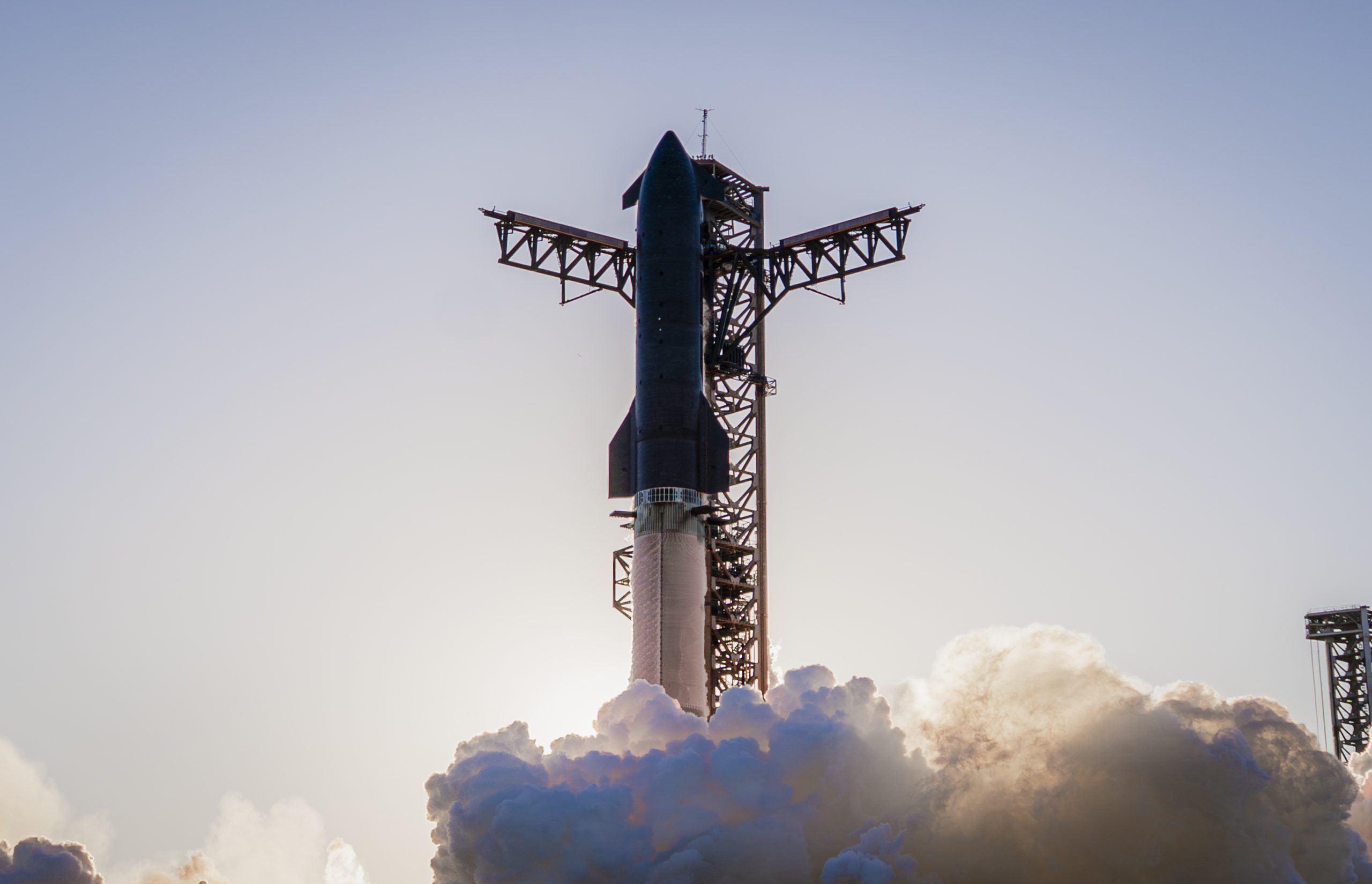
SpaceX recently shared an incredibly ambitious and bold update about Starship V3’s 12th test flight.
Despite the anomaly that damaged Booster 18, SpaceX maintained that it was still following its plans for the upgraded spacecraft and booster for the coming months. Needless to say, it appears that it will take more than an anomaly to stop SpaceX’s march towards Starship V3’s refinement.
Starship V3 is still on a rapid development path
SpaceX’s update was posted through the private space company’s official account on social media platform X. As per the company, “the Starbase team plans to have the next Super Heavy booster stacked in December, which puts it on pace with the test schedule planned for the first Starship V3 vehicle and associated ground systems.”
SpaceX then announced that Starship V3’s maiden flight is still expected to happen early next year. “Starship’s twelfth flight test remains targeted for the first quarter of 2026,” the company wrote in its post on X.
Elon Musk mentioned a similar timeline on X earlier this year. In the lead up to Starshp Flight 11, which proved flawless, Musk stated that “Starship V3 is a massive upgrade from the current V2 and should be through production and testing by end of year, with heavy flight activity next year.” Musk has also mentioned that Starship V3 should be good enough to use for initial Mars missions.
Booster 18 failure not slowing Starship V3’s schedule
SpaceX’s bold update came after Booster 18 experienced a major anomaly during gas system pressure testing at SpaceX’s Massey facility in Starbase, Texas. SpaceX confirmed in a post on X that no propellant was loaded, no engines were installed, and personnel were positioned at a safe distance when the booster’s lower section crumpled, resulting in no injuries.
Still, livestream footage showed significant damage around the liquid oxygen tank area of Booster 18, leading observers to speculate that the booster was a total loss. Booster 18 was among the earliest vehicles in the Starship V3 series, making the failure notable. Despite the setback, Starship V3’s development plans appear unchanged, with SpaceX pushing ahead of its Q1 2026 test flight target.
Elon Musk
Tesla CEO Elon Musk sends rivals dire warning about Full Self-Driving
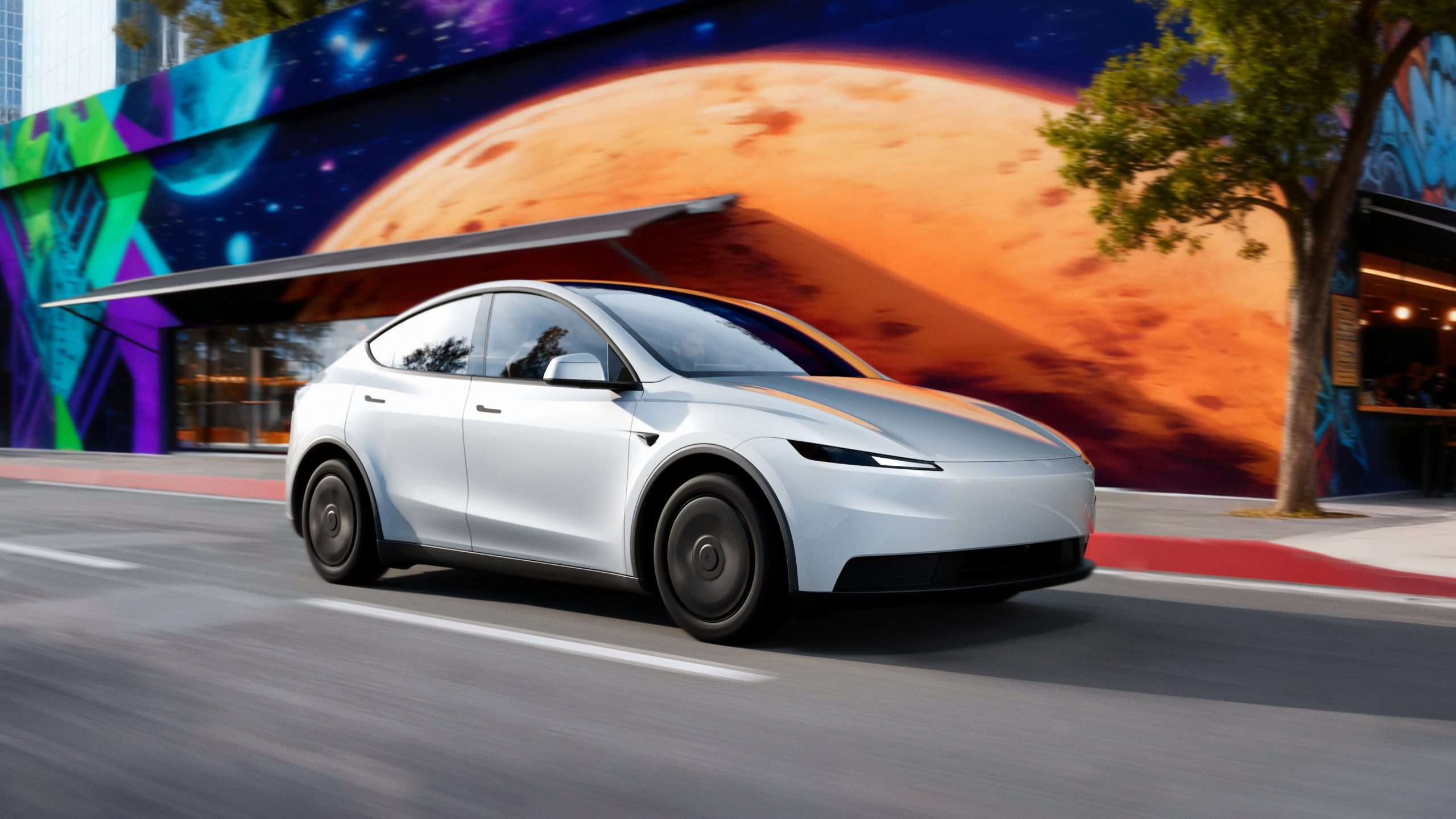
Tesla CEO Elon Musk revealed today on the social media platform X that legacy automakers, such as Ford, General Motors, and Stellantis, do not want to license the company’s Full Self-Driving suite, at least not without a long list of their own terms.
“I’ve tried to warn them and even offered to license Tesla FSD, but they don’t want it! Crazy,” Musk said on X. “When legacy auto does occasionally reach out, they tepidly discuss implementing FSD for a tiny program in 5 years with unworkable requirements for Tesla, so pointless.”
I’ve tried to warn them and even offered to license Tesla FSD, but they don’t want it! Crazy …
When legacy auto does occasionally reach out, they tepidly discuss implementing FSD for a tiny program in 5 years with unworkable requirements for Tesla, so pointless. 🤷♂️
🦕 🦕
— Elon Musk (@elonmusk) November 24, 2025
Musk made the remark in response to a note we wrote about earlier today from Melius Research, in which analyst Rob Wertheimer said, “Our point is not that Tesla is at risk, it’s that everybody else is,” in terms of autonomy and self-driving development.
Wertheimer believes there are hundreds of billions of dollars in value headed toward Tesla’s way because of its prowess with FSD.
A few years ago, Musk first remarked that Tesla was in early talks with one legacy automaker regarding licensing Full Self-Driving for its vehicles. Tesla never confirmed which company it was, but given Musk’s ongoing talks with Ford CEO Jim Farley at the time, it seemed the Detroit-based automaker was the likely suspect.
Tesla’s Elon Musk reiterates FSD licensing offer for other automakers
Ford has been perhaps the most aggressive legacy automaker in terms of its EV efforts, but it recently scaled back its electric offensive due to profitability issues and weak demand. It simply was not making enough vehicles, nor selling the volume needed to turn a profit.
Musk truly believes that many of the companies that turn their backs on FSD now will suffer in the future, especially considering the increased chance it could be a parallel to what has happened with EV efforts for many of these companies.
Unfortunately, they got started too late and are now playing catch-up with Tesla, XPeng, BYD, and the other dominating forces in EVs across the globe.
